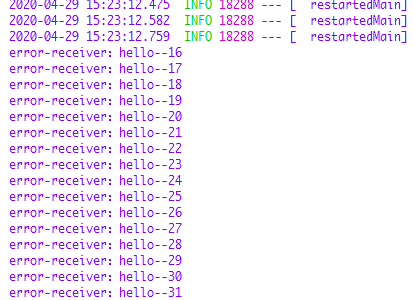SpringBoot+RabbitMQ学习笔记(五)RabbitMQ消息持久化处理
一丶简介

在@Queue和@Exchange注解中都有autoDelete属性,值是布尔类型的字符串。如:autoDelete=“false”。
@Queue:当所有消费客户端断开连接后,是否自动删除队列: true:删除,false:不删除。
@Exchange:当所有绑定队列都不在使用时,是否自动删除交换器: true:删除,false:不删除。
当所有消费客户端断开连接时,而我们对RabbitMQ消息进行了持久化,那么这时未被消费的消息存于RabbitMQ服务器的内存中,如果RabbitMQ服务器都关闭了,那么未被消费的数据也都会丢失了。
下面编写代码试试RabbitMQ的消息持久化处理。
二丶配置文件
这里使用的是前面博客里写的error日志消息队列来测试的。这里还是创建两个项目,一个作为生产者,一个作为消费者。
生产者配置:

server.port=8883 spring.application.name=hello-world spring.rabbitmq.host=localhost spring.rabbitmq.port=5672 spring.rabbitmq.username=guest spring.rabbitmq.password=guest spring.thymeleaf.cache=false #设置交换器名称 mq.config.exchange=log.direct #设置error队列的路由键 mq.config.queue.error.routing.key=log.error.routing.key
消费者配置

server.port=8884 spring.application.name=lesson1 spring.rabbitmq.host=localhost spring.rabbitmq.port=5672 spring.rabbitmq.username=guest spring.rabbitmq.password=guest #设置交换器名称 mq.config.exchange=log.direct #设置error队列名称 mq.config.queue.error=log.error #设置error路由键 mq.config.queue.error.routing.key=log.error.routing.key
三丶编写生产者

package com.example.rabbitdurableprovider; import org.springframework.amqp.core.AmqpTemplate; import org.springframework.beans.factory.annotation.Autowired; import org.springframework.beans.factory.annotation.Value; import org.springframework.stereotype.Component; /** * Author:aijiaxiang * Date:2020/4/26 * Description:发送消息 */ @Component public class DurableSender { @Autowired private AmqpTemplate amqpTemplate; //exChange 交换器 @Value("${mq.config.exchange}") private String exChange; //routingkey 路由键 @Value("${mq.config.queue.error.routing.key}") private String routingKey; /** * 发送消息的方法 * @param msg */ public void send(String msg){ //向消息队列发送消息 //参数1:交换器名称 //参数2:路由键 //参数3:消息 this.amqpTemplate.convertAndSend(exChange,routingKey,msg); } }
四丶编写消费者
这里消费者服务配置中@Queue中的autoDelete属性设置的是true,即未持久化,一会儿测试下看没有持久化的消息队列在所有的消费者服务器断开后是怎样的。

package com.ant.rabbitdurableconsumer; import org.springframework.amqp.core.ExchangeTypes; import org.springframework.amqp.rabbit.annotation.*; import org.springframework.stereotype.Component; /** * Author:aijiaxiang * Date:2020/4/26 * Description:消息接收者 * @RabbitListener bindings:绑定队列 * @QueueBinding value:绑定队列的名称 * exchange:配置交换器 * @Queue : value:配置队列名称 * autoDelete:是否是一个可删除的临时队列 * @Exchange value:为交换器起个名称 * type:指定具体的交换器类型 */ @Component @RabbitListener( bindings = @QueueBinding( value = @Queue(value = "${mq.config.queue.error}",autoDelete = "true"), exchange = @Exchange(value = "${mq.config.exchange}", type = ExchangeTypes.DIRECT), key = "${mq.config.queue.error.routing.key}" ) ) public class DurableErrorReceiver { /** * 接收消息的方法,采用消息队列监听机制 * @param msg */ @RabbitHandler public void process(String msg){ System.out.println("error-receiver:"+msg); } }
五丶编写测试类
这里写了一个死循环持续向消息队列中发送消息,用变量falg来记录发送编号。

package com.example.amqp; import com.example.helloworld.HelloworldApplication; import com.example.rabbitdurableprovider.DurableSender; import org.junit.Test; import org.junit.runner.RunWith; import org.springframework.beans.factory.annotation.Autowired; import org.springframework.boot.test.context.SpringBootTest; import org.springframework.test.context.junit4.SpringRunner; /** * Author:aijiaxiang * Date:2020/4/26 * Description: */ @RunWith(SpringRunner.class) @SpringBootTest(classes = HelloworldApplication.class) public class QueueTest { @Autowired private DurableSender durableSender; @Test public void test3() throws InterruptedException { int flag = 0; while (true){ flag++; Thread.sleep(2000); durableSender.send("hello--"+flag); } } }
先启动消费者服务器,然后启动测试类,控制台输出如下信息,然后关闭tomcat,模拟消费者服务器故障。这里可以看到消费者接受到的消息停留在第81条就出现了“故障”,但是生产者还是在持续不断的向消费者发送消息。

这时再重启tomcat,消费者又接受到了消息,但是是从第111条消息开始的,那么81-111之间的这些消息就都丢失了。

修改消费者服务的代码,将autoDelete设置为“false”,将RabbitMQ消息进行持久化处理。
@RabbitListener( bindings = @QueueBinding( value = @Queue(value = "${mq.config.queue.error}",autoDelete = "false"), exchange = @Exchange(value = "${mq.config.exchange}", type = ExchangeTypes.DIRECT), key = "${mq.config.queue.error.routing.key}" ) )
修改后重启消费者服务器,再次调用测试方法。然后关闭消费者服务器,模拟“故障”。这时看到消息接收到第15条服务器就“故障”了。

重启消费者服务器。可以看到服务器一启动,消费者就从消息队列中读取到了服务器“故障”时缓存在RabbitMQ中的消息,消息并未丢失,RabbitMQ消息持久化处理成功。

OK!以上就是今天学习的RabbitMQ消息持久化处理,如有不对之处,欢迎指正!








【推荐】国内首个AI IDE,深度理解中文开发场景,立即下载体验Trae
【推荐】编程新体验,更懂你的AI,立即体验豆包MarsCode编程助手
【推荐】抖音旗下AI助手豆包,你的智能百科全书,全免费不限次数
【推荐】轻量又高性能的 SSH 工具 IShell:AI 加持,快人一步
· AI与.NET技术实操系列:基于图像分类模型对图像进行分类
· go语言实现终端里的倒计时
· 如何编写易于单元测试的代码
· 10年+ .NET Coder 心语,封装的思维:从隐藏、稳定开始理解其本质意义
· .NET Core 中如何实现缓存的预热?
· 25岁的心里话
· 闲置电脑爆改个人服务器(超详细) #公网映射 #Vmware虚拟网络编辑器
· 基于 Docker 搭建 FRP 内网穿透开源项目(很简单哒)
· 零经验选手,Compose 一天开发一款小游戏!
· 一起来玩mcp_server_sqlite,让AI帮你做增删改查!!